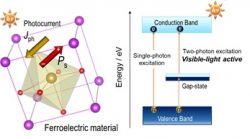- HOME
- RESEARCH
- Research Units
- Ferroelectric Photovoltaics
RESEARCH
Ferroelectric Photovoltaics
Ferroelectric materials exhibit a characteristic photovoltaic effect that can generate photovoltage far exceeding their bandgap energy. The absence of limitation in the photovoltage by the bandgap is a great advantage of the ferroelectric photovoltaic (FPV) effect over the conventional PV effect in p-n junctions of semiconductors. Since typical ferroelectric oxides have the wide bandgap, a vanishingly small photoresponse under visible light has been an issue to be overcome. To activate the photoresponse under visible-light irradiation, Matsuo and Noguchi have proposed a materials design strategy ‘gap-state’ engineering, in which defect states within the bandgap derived from intentionally introduced impurities act as a stepping stone for photocarrier generation. The aim of this research unit is to clarify the photovoltaic properties and photocarrier dynamics in transition metal-doped ferroelectrics with the gap states. In this collaboration research, Ceracomp Co., Ltd. supplies ferroelectric single crystals synthesized by a solid-state single crystal growth (SSCG) method and their FPV properties are evaluated in Kumamoto university. The SSCG method is a cost-effective crystal growth method that enables the fabrication of single crystals with complex chemical compositions which are difficult to obtain in conventional melt-growth techniques. By combining the gap-state engineering and the SSCG method, we will develop novel ferroelectric materials that exhibit enhanced FPV response under visible light irradiation.

Unit members
-

-
 Sub-CoordinatorYuji NOGUCHI Website
Sub-CoordinatorYuji NOGUCHI WebsiteProfessor
Research and Education Institute for Semiconductors and Informatics, Kumamoto UniversityJapan -
 Ho-Yong LEE
Ho-Yong LEEProfessor
President, Ceracomp Co., Ltd.Korea -
 Moon-Chan KIM
Moon-Chan KIMResearcher
Ceracomp Co., LtdKorea
Achievements
Publications
Grants
Activities
Presentations
- (Invited) Hiroki Matsuo, Yuji Noguchi “Activation of Visible Light Response in Ferroelectric Photovoltaic Effects via Gap-State Engineering”
The Joint International Conference on Applied Physics and Materials Applications & Applied Magnetism and Ferroelectrics (ICAPMA-JAMG-2021), December 2021, Pattaya (Virtual) - Hiroki Matsuo, Yuji Noguchi “Gap-State Engineering for Enhanced Ferroelectric Photovoltaic Effect under Visible Light Irradiation”
2021 MRS Fall Meeting & Exhibit, December 2021, Boston (Virtual) - Hiroki Matsuo, Yuji Noguchi “Photovoltaic properties of BiFeO3-based ferroelectric thin film via gap-state engineering”
The 50 th Japan Conference on Crystal Growth, October 2021, Virtual.
- Units of World-leading Researchers
-
- Development of Nano and Supramolecular Materials
- RNA Biology
- Plant Cell and Developmental Biology
- Nano-Organics and Nano-Hybrids
- Nano-medicine and Drug Delivery System
- Nano-medicine and Theranostics
- Multiscale Modeling of Soil and Rock Materials Using X-ray CT
- Quantification of Three Dimensional Vascular Network
- MicroCT-based Quantification of Fibrosis and Vascularization in Pancreatic Tumor
- Advanced Structural Materials
- Microstructure Analysis and Grain Boundary Engineering
- Structure and Dynamics of Materials Using Quantum Beams and Data-Driven Sciences
- Hydrological Environments
- Nano-materials for Energy Applications and Environmental Protection
- Units of Young Researchers
-
- Quantitative Bioimaging
- Development of Novel Therapeutic Strategy Using Iron Targeted Upconversion Nanoparticles for Parkinson's Disease
- Deep Learning for Hydrology
- Environmental Impacts of Ionic Solutes
- Study of first-generation objects in the universe with radio telescopes
- Plant Stem Cells and Regeneration
- Development of Microbially-Aided Carbon Sequestration Technology
- Advanced Biomedical Evaluation System
- Bio-inspired Functional Molecular System
- Nanomaterials Processing for Medical, Cosmetic, and Environmental Applications
- Ferroelectric Photovoltaics
- Next-Generation Design of Structures



